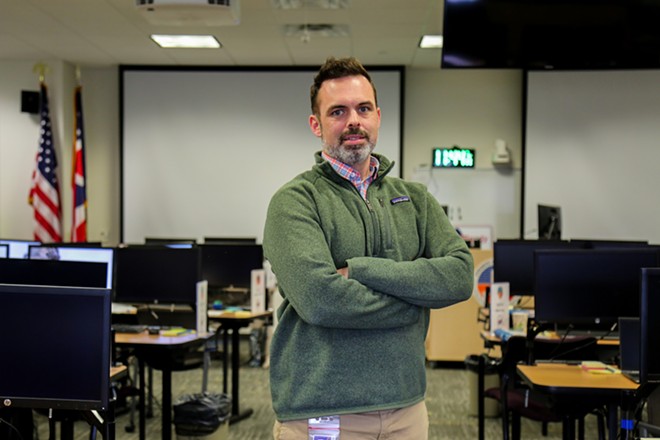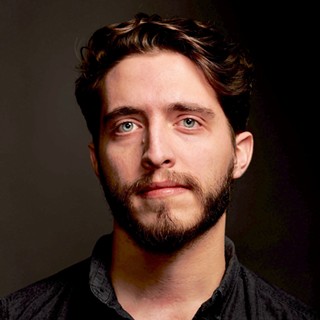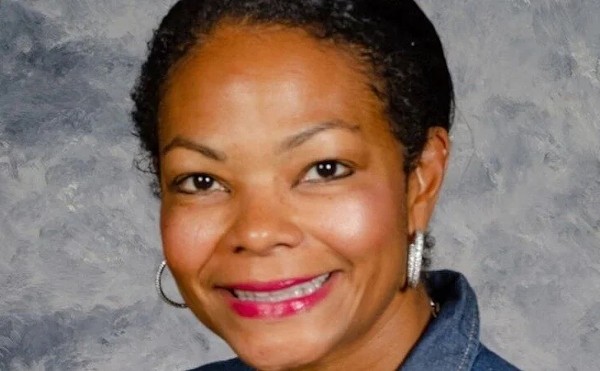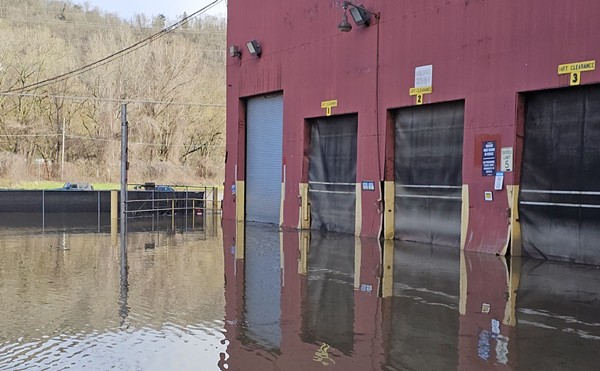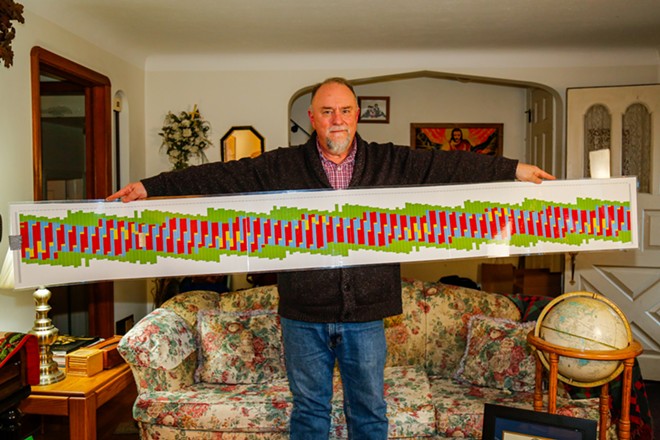
That roughly four minutes, as foretold for centuries, is the time during the day in which we will be without our sun. We’re told, as Ryan’s been talking about ad nauseam since last March, that on April 8, from 3:13 p.m. to 3:17 p.m., Clevelanders will be privy to a total solar eclipse, in which the moon blocks out sunlight, casting a 124-mile-wide dark shadow that will stretch from Toledo to Canton.
Crickets chirp. Chickens roost. Birds stop singing.
“The cows get confused, and go home,” Ryan said. “And people, some people just lose their heads. They scream. They laugh. They cry. They sob uncontrollably. Whatever your personality is, that is how you’re gonna react.”
Ryan, 62, is a self-described amateur astronomer living with his wife and daughter in Old Brooklyn who, for roughly four years, has been talking to a network of institutions that have been preparing the city, and the region, for April 8th’s natural phenomena. And, of course, its unpredictability: from the incoming hordes of eclipse tourists descending on Northeast Ohio—an influx estimated to be anywhere from 200,000 to 500,000—to the exact pockets of the county, or state, they’ll be clustered in to the prevalence of clouds in those four precious minutes.
This fragility gives Ryan, as it gives his milieu of amateur astronomers, a particular kind of anxiety. For about 5,000 years, human beings have been recording, and predicting, a marvel over the sudden extinguishing of sunlight. By around 2,000 B.C.E., Babylonians parsed this into a type of proto-science called the Saros cycle, finding that lunar and solar eclipses repeat, somewhere on the planet, precisely every 18 years, 11 days and eight hours. (Ryan keeps a laminated printout of this cycle on his dining table.) Herein lies Ryan’s jolt: explaining to those both the brevity of a highly particular phenomenon and convincing skeptics of a total eclipse’s emotional punch.
That is, obviously, if those here in Cleveland on April 8 can actually see it. Regardless of the sky that afternoon, Ryan, along with the rest of the Solar Eclipse Task Force, has had to prepare for favorable weather.
As of early March, every hotel in Downtown Cleveland has been booked, with fees running four to five times the average weekend rates. (One Airbnb, an apartment downtown, went for $3,600 a night.) County and city emergency management teams have requested hundreds of traffic barriers and porta johns. The Ohio Department of Transportation is relocating temporary construction along all highways, and anticipating hours of gridlock. And NASA Glenn, the sole NASA research center in the Path of Totality, from Montreal to Kerrville, Texas, will be hosting about three dozen engineers to, they hope, better study a crystalline view of solar flares. An astronomy meet, a NASA spokesperson said, makes Cleveland “the prime spot for the eclipse broadcast.”
Along with creating his Eclipse Over Cleveland website, and selling 31,000 branded viewing specs, Ryan has embarked on months of a lecture tour to try and sell the eclipse’s personal worth to a general audience. A similar plunge has been taken by those like Ryan, whether it be pros with academic tenure or armchair aficionados, who have been releasing books, headlining university or library talks, participating in dayslong media tours.
“I’ve been pretty much booked up now for almost a year,” Gary Kader, the director of Baldwin Wallace’s Burrell Observatory, said outside a BW lecture hall in early February. Kader was slated to say a few words to the Cleveland Astronomy Society, after NASA astronomer Kelly Korreck detailed, via Zoom, her own predictions. As Kader made his. “You have to understand that this is a human event,” he said, recalling the three totals he’s witnessed in his 75 years. “If you’ve seen one, you can understand why people thought it was the end of the world. Quite frankly, it’s disorienting.”
After an eclipse-themed book raffle, the CAS started its main event for the thirty or so in attendance, mostly those in rain jackets and white hair. Korreck presented in a twofold manner: On one end, April 8 is a day NASA can better study solar flares. (“The sun is a curious beast,” she said.) On the other, a day ripe with existential wonder.
“There is no other place in the universe with a moon this big, this far away from the earth, and to cover the sun up exactly in this very way,” Korreck said. Kader nodded in the second row. “I want you to let that sink in for a minute. How powerful that is.”
There was pandemonium in Beijing in the middle of October in 2,134 B.C.E. A sudden engulfment of the sun, the Chinese believed, meant it had been “eaten” by a celestial dragon, a sort of godly punishment for bad society mores. People flooded the streets banging pots and pans at the dark circle in the sky. Others hid in their homes. As legend has it, Emperor Shun was so enraged by the sun-devouring that he ordered his staff astronomers, Hsi and Ho, beheaded for failing to do their job. (They, the legend also tells us, were simply too drunk.)
Weather, as both NASA engineers and meteorologists know, is a fickle beast to foretell. Besides the half dozen weather balloons floating around the Midwest, and automatic readings from jets soaring the stratosphere, a lot of what can be assumed about a day’s precipitation or sunlight is often gleaned from historical records. According to the National Weather Service, 13 of the past 23 April 8ths had precipitation of some kind—five days, like 2018 and 2016, carried snow.
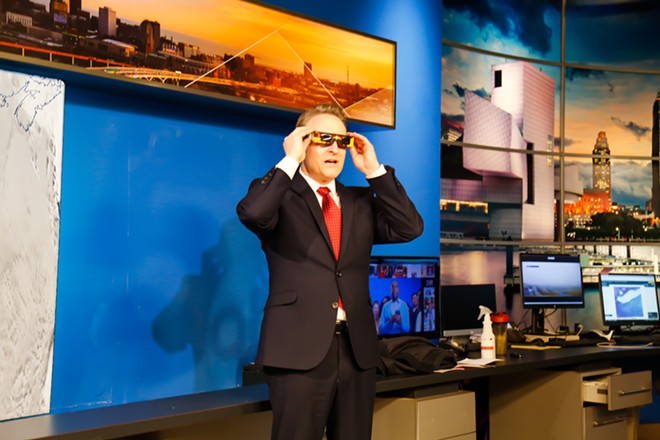
“Well, here’s the problem,” Mark Johnson, News 5’s chief meteorologist told Scene, from his newsroom off Euclid Avenue. “If you look back at history for these last twenty years, cloud cover on any April 8th afternoon in Northern Ohio is sixty to eighty percent.” Johnson put up a weather map on the forecast wall near his desk. A dark gray blob encompassed a large swath of Ohio, Michigan and New York. “Let me put it this way. The odds of it being a cloudless day are slim. Really, really slim.”
A native Clevelander who made his first report for News 5 in November of 1993, Johnson likes to describe his job as one neighboring astronomy, through the umbrella, he says, of “space weather.” “I have a permanent crick in my neck from stargazing,” Johnson said. This reputation divulging the Lake Effect to trusting Northeast Ohioans carries a kind of social contract Johnson has little say in. He must report what little data—from one satellite and four balloons—he receives already.
It’s a fear that makes April 8 Johnson’s Gladiator moment, to put it facetiously. A recent run-in with fans at his daughter’s volleyball game told him so. “I had three or four people come up to me, and say, ‘How’s it feel to get it wrong all the time, and still have a job?’” Johnson said. He adjusted his red tie. “‘You’re wrong all the time!’ Well no, actually I’m not.” (He’s accurate about “85 percent of the time.”)
Forty-eight hours before totality, around the usual time Johnson starts his shift at News 5, meteorologists around the region will be able to predict, with more assurance, what the sky will look like that Monday afternoon. Or what it could look like.
The only problem is, if Johnson’s worst fear is right, and 3:13 p.m. bears cloud coverage, then that report will divert hundreds of thousands southward towards better weather predictions. That is, to Mansfield or Dayton, to Indiana or Texas. (Even Texas is a fifty-fifty gamble, weather wise.) Hundreds if not thousands of hotel rooms booked a year in advance could, in theory, sit empty as a mad rush of eclipse tourists flee a city that had planned for two years to accommodate them.
Bryan Kloss and Mark Christie at the Cuyahoga County Emergency Management will have to deal with it. Two years of exact plans, of joint collaboration with fifteen agencies and a “100-plus”-page preparation report, could go to Plan Bs and contingencies they’ve prepped for. A darkened, cloudy sky could cause accidents. Cell phone towers, as what happened during Nashville’s 2017 total eclipse, could go down for hours.
“Best case scenario: It’s a sunny day, everybody has a wonderful time, and we’re able to move traffic through nicely without having to worry about road closures,” Kloss told Scene, sitting in the GIS section of the command center he helps oversee, rows of computers behind him. “People enjoy the event. It’s sunny. It’s warm. They go to the beach. They go to the fields. They enjoy it, and they all go home. That’s what our job is: to make sure they all go home safe.”
On a recent Thursday afternoon, Johnson walked into his studio in an electric-blue suit to once again detail what he believes might happen that day in April. A father-of-three with the high energy of a Bill Nye, Johnson veered between a Trekkie-type anticipation and a jester’s anxiety as his two colleagues, Kate McGraw and Katie Ussin, recorded an April 8 promo nearby.
“I’m manifesting it to be clear,” McGraw told Scene, with a wink, after the broadcast. She smiled. “I’m just going to put out good vibes, that we’re going to have clear skies.”
“Thousands and thousands of people—I’m their guy,” Johnson said, as McGraw and Ussin played back their promo. “The pressure is on.” He took a breath. “I wake up in a cold sweat just about every night going, ‘Oh my gosh, what if? I mean, what if?”
“And if we do fail?” he added. “I may jump on a plane for a week or so.”
On a recent Friday in March, Catherine Urban cleaned her two-story house, said goodbye to her husband and two kids, and took a seat at her dining room table in Edgewater. Her laptop is open in front of her, as is The New American Ephemeris. There are salt crystals nearby. An album called “The Zodiac Cosmic Sound” is framed on the wall.
“Eclipse time is usually not an easy time,” Urban said, calmly. “It’s a time where we often feel like our walls are getting smaller.”
Farrah, 36, is sitting across from her, in serpent earrings and hands cupped on her waist. “So, my mother-in-law just moved in,” she said. “They’d sold their house. My husband’s parents got divorced, she moved in with us. And her birthday is mid-April, which I find interesting. And she’s trying to move.”
Urban leans in a bit closer to her laptop screen, as if to second guess the astrological chart displayed on it. “So she’ll be impacted by eclipse season, too.” She checked chart notes on her Steno pad, where, earlier that day she made the same for Donald Trump and Joe Biden. (“Don’t forget, Twitter was bought by Elon Musk in eclipse season,” Urban said.)
Farrah giggled anxiously. “Well, I feel now there’s a lot of positives,” she said. “I didn’t know what I was walking into.”
“Solar eclipses tend to bring in more elements that feel fated, they feel out of our control,” Urban said. Her hands grow animated. “People tend to feel like it clears the path for them so they could bring something forward, so that they could actualize something they came here to do.
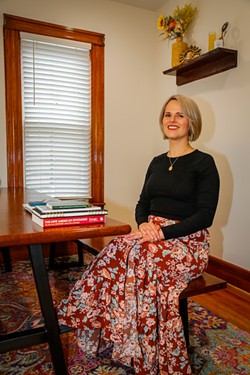
Growing up in Chagrin Falls intrigued by her grandparents’ New Age library, Urban began pursuing work as a professional astrologer in her mid-twenties. Soon, she studied with famed New York astrologer John Marchesella, and hosted guest lectures in Lilydale, New York, the Spiritualist center of the United States. She’s written an astrology-themed cookbook. She’s since given thousands of readings. “I have clients all over the world,” she said.
The most important reading might have been her own, circa 2017. Her then-boyfriend Eli, who Urban had been with since meeting in cosmetology school, had suggested the two travel to Asheville on August 20, to see their first total eclipse on the Hard Times Trail. To Urban’s surprise, Eli proposed. (“I had no idea,” she said.) Urban said yes. The next day, on a lake in Georgia, they embraced as the moon engulfed the sun.
“It was life-altering,” Urban said. “When I think about some of the most amazing and ecstatic things I’ve experienced, it felt like laying eyes on my newborn children.” Second to…
That day, after Farrah’s reading, Urban’s kids arrive home with Eli. Urban’s oldest leapt boisterously into her arms at the kitchen table. “He’s like me,” Eli said. “Total Aquarius.”
Thirty-one days before Cleveland hypothetically doubles in size, Jay Ryan sat at his dining room table in Old Brooklyn to once again discuss the implications of those three minutes and fifty seconds. In front of him is an 1806 Almanac, his laminated, eight-foot print out of the Saros cycle. An article in the Old Brooklyn News he’s given to each member of Cleveland City Council. In the basement is Ryan’s Dobsonian telescope he built out of rebar and concrete Sonotube.
“Oh, Dad talks every single day about the eclipse,” Ryan’s teenage daughter Flo said while doing homework in the kitchen. “Every day.”
Which, of course, begs the question: What is Ryan to do on April 9? After the half million or so drive or fly back to their homes—presumably with new takes on their lives. After the Guardians play their home opener to a sold-out crowd in the aftermath. After all the barriers and porta johns are removed, after construction dividers and crews return to daily labor on the highways.
Ryan sort of bucks the question. “It may come as a surprise to some people, but I have other things I’m interested in,” he said, laughing. He recalled the Cleveland he grew up in, the city ununified, that city known for its river fire, that city used as the butt of a Johnny Carson joke. “I’m hoping that this will be a turning point for Cleveland, Ohio,” Ryan said. “And I’m hoping that this eclipse will close the deal once and for all on the Cleveland renaissance. I’m hoping that we’ll turn a corner. I’m hoping that this community will come together.”
As for any life change in Jay Ryan, the best the eclipse ambassador can do is relate his own story of 2017, when the Ryans drove down to Hartsville, Tennessee, to catch the total with hundreds of friends and family members. As the sun’s corona began to flicker, a phenomenon called Baily’s Beads, Ryan’s wife and others let out a series of ahs and gasps. Others laughed. Some cried.
“There were no surprises for me,” Ryan recalled. “I was already so old, and so well-versed in the subject, I knew exactly what to expect.”
Ryan cackled, realizing the absurdity. “I guess it was just my personality, something about myself I never truly understood.”
Subscribe to Cleveland Scene newsletters.
Follow us: Apple News | Google News | NewsBreak | Reddit | Instagram | Facebook | Twitter | Or sign up for our RSS Feed

